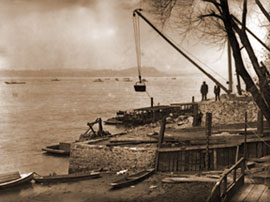Mira Lloyd DockBorn in Harrisburg, Mira Lloyd Dock was the daughter of businessman Gilliard Dock and Lavinia Bombaugh Dock. She was a nurse, reformer, author, and woman ahead of her time. At the turn of the century there was great interest in beautifying communities throughout the United States. Civic-minded residents of Harrisburg were convinced that the city had to implement progressive changes tantamount to its stature as the capital city. Parts of the city of Harrisburg in the late nineteenth century would seem uninhabitable when compared to today's standards of living. Sewage contaminated unpaved streets and the Susquehanna River, making diseases common and recurrent. Homes and businesses butted against each other. Following the devastating Hills Capitol fire in February 1897, Harrisburg had slowly begun to transform from a mud-encrusted, filth-strewn industrial town, into a more beautiful city largely due to construction of the new 1906 Capitol, which did much to elevate civic pride. Mira Lloyd Dock publicly challenged the horrible conditions and set out to motivate public sentiment in support of changing them. Dock was a well-educated and traveled woman. She represented the "new woman" at the turn of the twentieth century, college-educated with an eye for civic change and social activism. In 1900 at the age of 47, Dock presented a speech to the Harrisburg Board of Trade on December 20. Her speech, titled "The City Beautiful," or "Improvement Work at Home and Abroad," was the starting point for Harrisburg's city improvement. Dock's contemporary and closest ally in her crusade for urban beautification was J. Horace McFarland, president of the American Civic Association. Together they spurred the process of municipal improvement for Harrisburg by convincing influential community leaders to donate money, and by garnering the support of the majority of citizens. In April 1901 the Harrisburg Telegraph published a front-page article about the city's problems. The article stressed Dock's message of beautification and recreation, paved streets, clean water, a city hall, land for parks, and a covered sewer interceptor along the river. Within fifteen years, all of these improvements and more were in place. In 1901 she was appointed to the State Forestry Commission and served until stepping down in 1913. Throughout her time on the Forestry Commission, she traveled the state inspecting lands and recommending their purchase. Beginning in 1903 she began to lecture in botany at the newly established State Forestry Academy at Mont Alto, (a school she had helped to establish). After stepping down from her position with the Forestry Commission she continued to advocate for numerous causes including J. Horace McFarland's campaign to preserve Niagara Falls, women's suffrage and the conservation movement. At a time when women were expected to remain in the background and certainly not participate in the debates of the day, Dock had the courage and determination to step forward and make a difference. Unfortunately, she received very few accolades during her lifetime. Dock passed away in 1945 and was laid to rest in the family plot with her parents and grandparents in Harrisburg Cemetery. |
MIRA LLOYD DOCK SUSQUEHANNA RIVERBANK |

